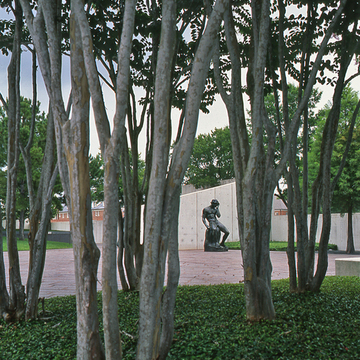Japanese American sculptor Isamu Noguchi shaped the flat, featureless lots where the Cullen Sculpture Garden was constructed as a meditation on Houston space. Noguchi used constructed landforms to intensify the sensation of Houston's flatness. His granite-paved causeways angle and arc to induce a feeling for what architect Michael Bell described as the Houstonian sensation of “slow space.” By walling out traffic on Montrose Boulevard and Bissonnet Avenue and an adjacent parking lot, Noguchi reinterpreted Houston as a garden city studded with such architectural monuments as the neo-Georgian spire of the First Presbyterian Church of 1949 by New York City architect Hobart Upjohn and Houston architect Maurice J. Sullivan at 5300 Main Boulevard and the neo-Gothic St. Paul's United Methodist Church of 1930 by Alfred C. Finn at 5501 Main Boulevard. Accessible from the Cullen Sculpture Garden is the museum's art school, the Glassell School of Art of 1978 by S. I. Morris Associates at 5101 Montrose Boulevard.
You are here
Lillie and Hugh Roy Cullen Sculpture Garden, Museum of Fine Arts, Houston
If SAH Archipedia has been useful to you, please consider supporting it.
SAH Archipedia tells the story of the United States through its buildings, landscapes, and cities. This freely available resource empowers the public with authoritative knowledge that deepens their understanding and appreciation of the built environment. But the Society of Architectural Historians, which created SAH Archipedia with University of Virginia Press, needs your support to maintain the high-caliber research, writing, photography, cartography, editing, design, and programming that make SAH Archipedia a trusted online resource available to all who value the history of place, heritage tourism, and learning.


